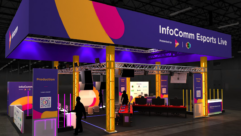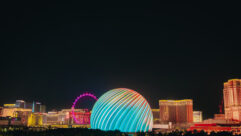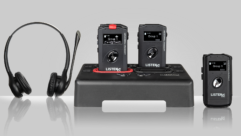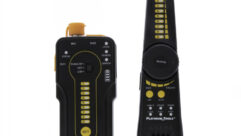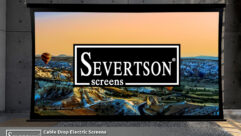INFOCOMM 2001 Wrap-Up
Aug 17, 2001 12:00 PM,
Peter H. Putman, CTS
It was inevitable that INFOCOMM, the industry’s pre-eminentA/V show, would wind up in Las Vegas, the glitz capital of the world.The overwhelming number of electronic display technologies seen atINFOCOMM fit naturally with the video-in-your-face atmosphere all overthe city.
Venue wasn’t the only change this year. A new leadership teamfrom ICIA was at the helm, along with a new logo and branding campaignfor INFOCOMM. There was a record number of educational seminars,accompanied by several manufacturer-sponsored seminars.
Trade show floor space expanded to a new high of 513 exhibitorsoccupying nearly 300,000 square feet inside the Sands Expo Center. Theserendipitous contiguity of the Venetian and Sands show floors made itconvenient to dash from booth appointments to classes and back to thefloor.
Main Themes: Aggressive Pricing and Line Expansion
That said, there really wasn’t much technological breakthroughthis year. Rather, the show reflected the vagaries of the nationaleconomy—aggressive product pricing and line expansion were thehot topics of the 3-day event. The cutthroat discounting started bySony in 1999 with the VPL-CS1 LCD projector sent shock waves throughthe industry that were still being felt at this show.
Ditto the lowball moves by Sony in the fall of 2000 with its 42-inchPFM-42B1 plasma. As a result, several companies dropped 50-inch panelprices into the $17,000–$18,000 range earlier this year, butPanasonic pulled the rug completely out from under them by introducingits 50-inch TH-50PHD3U at the show with a surprising $13,995 MSRP. (NowNEC knows what to charge for its new 61-inch plasma panel—the old50-inch price!)
Predictions were made at NAB 2001 that we might see 50-inch panelsunder $10,000 by the end of this year, and that’s looking like aneven stronger bet right now.
Extron Electronics had one of the broadest lines of new products,including a media control system that seems to be treading intoCrestron and AMX territory (although Extron says that’s not thecase). Speaking of AMX, they’re back, having consigned the Panjaname to history. Upstart Kramer Electronics, with its strong managementteam, took dead aim at a piece of Extron’s business (and some ofFolsom’s, too) with low-priced interfaces and seamless video/RGBscaler/switchers.
Clarity, Synelec, Mitsubishi and ImTech are burying the termvideowall in favor of datawall, having mined a rich new niche market inthe financial and public display industries. NEC, Epson, Sony, Barco,Mitsubishi and others featured at least one IP-enabled projector and/orplasma monitor, reflecting the increasing interest in blending LANs andthe A/V world.
JVC surprised everyone by showing a new and improved QXGA D-ILAprojector (yes, that’s 2048 by 1536 true pixels, unlike theLasergraphics enhanced-XGA LCD projector), but Hitachi, Philips, Sanyo,3M, Samsung and InFocus also got into the LCoS act. There’s afair amount of money riding on reflective liquid crystal forhigh-resolution imaging, so look for more companies to get into thisgame shortly.
The other big news was the proliferation of ultra-micro DLPprojectors, led by Plus with its new sub-2-pound design. As I said toTI officials, it’s now possible to lose both the remote and theprojector behind your couch! Similar mockups and prototypes were seenfrom InFocus, Sharp, Mitsubishi, Philips, Acer, Compaq and others inthe TI DLP booth. These products will also be aggressively priced,which will inevitably show up at the large computer and office supplydiscounters.
So What Happened at the O.K. Corral?
Last year, I dropped my annual (since 1994) analysis of theProjection Shoot-Out due to the withdrawal of Sony and Christie and asub-par staging in Anaheim. At that time, I made an observation (whichturned out to be rather controversial) that the event appeared towobbling on its last legs.
Well, if this year was any indication, that observation was not faroff the mark. Following Sony’s and Christie’s lead, severalother manufacturers skipped the Shoot-Out entirely and concentrate onbooth space instead. The Shoot-Out hall was noticeably smaller thisyear, with 84 entries dominated by the likes of Sanyo, Mitsubishi,Panasonic, Sharp, Viewsonic and Hitachi. At least one of thisyear’s participants told me they wouldn’t be back for 2002,since the absence of virtually all the market leaders rendered thecompetition virtually meaningless. Buyers now look for the lowest pricein a given brightness/resolution category, not the best-looking orbrightest image.
Two of this year’s Shoot-Out categories featured exactly oneentry each, while seven had all of two entries apiece. The largestcategory in 2000 (1024×768 desktop projectors) featured 27 entries;this year, the largest category featured 15. However, there was abright spot: The test images featured pop-up word balloons thatinstructed a viewer where and what to look for in a given test image,which was a great idea on the part of the Shoot-Out committee led bySteve Somers of Extron.
What about next year? There was talk of merging or blending theShoot-Out into another, adjoining exhibit called the Display SystemsEncounter. This might be a good idea, with an increased emphasis oneducation at INFOCOMM and reluctance on the part of exhibitors to spendextra money outside of their booth space.
The feeling here is that INFOCOMM is a strong, unique trade show;able to survive on its own without the Shoot-Out, if it comes to that.The record number of seminars, increased booth-space sales and thegeneral positive buzz are all ample proof.
The Show in a (Rather Large) Nutshell
After 30 pounds of literature and several hours of note-taking,I’ve prepared a distilled version of the show. With severalhundred exhibitors, it was impossible to visit everyone. For those Imissed, my apologies. It wasn’t intentional; there justaren’t any 36-hour clocks available!
While there’s a ton of things to see at INFOCOMM, I’vehighlighted some selected products in color. This means I thought thatparticular product—or the technology it represents—wassignificant and not just the same old, same old.
Projectors: A Mother Lode
Projectors make the show go, and this year INFOCOMM featured adizzying number of new projectors.
InFocus revealed a line of microportables, desktops and installationdesigns. For INFOCOMM, the company announced the LP290, anASK-designed, 5.7-pound desktop, XGA (1024 by 768) LCD projector.It’s got a really nice European look and develops 1100 ANSIlumens. More importantly, it has a suggested MSRP of $3999.
InFocus also unveiled the LP530, another 5.7-pound projector thatuses DLP technology. It also features XGA resolution but is one of thefirst single-chip DLP projectors to break the 2000-lumens barrier.Variable brightness settings for economy, video signal processing bySage (Faroudja) and a suggested price of $4999 round out the picture.For installations, InFocus offers the Proxima Pro AV 9410, a 1280x1024box rated at 3700 ANSI lumens and 600:1 contrast, with interchangeablelenses.
JVC’s demo of the DLA-QX1 consistently brought in big crowds.The model on display was rated at 7000 ANSI lumens and greater than1000:1 contrast. And although it still had a few image artifacts, itlooked substantially improved from its debut at ShoWest. The DLA-M5000Land DLA-M5000SC large-venue D-ILA projectors were also out for viewing.Both feature 1365×1024 native resolution and are rated at 5000 ANSIlumens. For the portable and desktop market, JVC also showed theDLA-DS1, an updated version of the DLA-3010Z prototype. This 14.3chassis has SXGA resolution and is rated at 1300 ANSI lumens, making itthe smallest (so far) and least-expensive (at $8995) SXGA projector onthe market. For the home theater and cinema crowd, JVC demonstrated theDLA-G150HT CineLine projector, using a proprietary Video Gamma Profilegrayscale tracking system to maintain true D-6500 color balance, ratedat 1000 ANSI lumens.
Panasonic had a striking demo of its near-DLP-Cinema projectordesign, the PT-D9610U. Although Panasonic is not one of the threeofficial DLP Cinema licensees, it has tinkered with the optical path,mirrors and added another aperture to lower black levels and boostcontrast. I had to admit the results were quite impressive for a”standard” large-venue DLP chassis. (When asked, some Texas Instrumentsrepresentatives stated they encouraged all of their customers’efforts in making advancements to DLP imaging, but at least one personat TI “wasn’t too thrilled” with Panasonic’s efforts toblur the standard DLP and DLP-Cinema boundaries.)
Panasonic also had the PT-L711XNTU ultra-portable on display, usinga wireless interface to communicate with a nearby 802.11b-equippednotebook computer. Two new portable LCD projectors entered the line:the XGA-resolution PT-L759XU (3100 lumens) and PT-L759VU (2400 lumens).Panasonic’s ultra-portable line has expanded by five models,ranging from the PT-L711XU (XGA, 1600 lumens) to the PT-L501XU (SVGA,1200 lumens).
Christie Digital announced the sale of the DigiPro DLP Cinemaprojector to Industrial Light and Magic just before the show, whichgave the company some nice momentum. At the Christie booth, the VividRed LCoS front projector was in the spotlight. This model uses three0.9-inch D-ILA panels (yes, they’re from JVC) and features SXGA(1365 by 1024) native resolution. It’s rated at 1800 ANSI lumensand 500:1 contrast.
Enhancements were also announced to existing Christie models. TheRoadster X4/S4 and Roadster X6/S6 modular DLP projectors got a boost to4000 and 6000 lumens respectively, and feature new stacking and riggingsystems. A partnership was announced with 3D Perception to use CompactUtechnology inside Christie projectors for simulation and 3D curvedscreen projection. (It works, but you still need those specialglasses.)
Mitsubishi promoted the heck out of its sRGB-compliant projectors,showing off the new X500 desktop/installation projector (16 pounds,3700 lumens, XGA), the 1024×768 X490 and 800×600 S490 (2500 lumens, 16pounds), and the super-small XL1 and SL1 compact LCD projectors (1000lumens, 6.5 pounds). Mitsubishi also had a demo of the Mini-Mitsmicroportable DLP projector, and it’s reasonable to assume thatan even smaller version will follow soon.
NEC Technologies brought plenty of new products along. Its MultiSyncGT950 desktop/installation projector has true (not digital) dual-axiskeystone correction, a must for stacking and seamless image projection.This 15-pound projector uses XGA LCD technology and can be fitted withan optional LAN card. NEC’s GT2150 now occupies the top of theLCD category for NEC, delivering 1365×1024 resolution, 3:2 pulldowncompensation, interchangeable lenses and DVI input.
Upgrades to the LT-series were also on view, with the LT75 (SVGA)and LT150z (XGA) both delivering 1000 ANSI lumens and a claimed 800:1contrast. Each projector has a built-in flashcard reader fornotebook-less presentations, as well as NEC’s Vortex imageenhancement technology. Across the aisle, some new additions to theNighthawk line were showcased. The SX10000 is an 8000-lumen, SXGA (1280by 1024) DLP large-venue chassis; while the XT4100 (XGA) and S4100(SXGA) are more compact 3-chip DLP designs for small to mid-sizedinstalls. Both are rated at 3500 ANSI lumens brightness.
Epson has been doing its homework and announced a trio of portableprojectors at the show. The PowerLite 810p is a 2000-lumen XGA chassisthat weighs 9.3 pounds. The PowerLite 800p is identical except for 1500lumens brightness. For SVGA fans—including the budget-consciouseducational market—the PowerLite 600p presents 1700 lumens in a9.3-pound package. All three models support the sRGB color standard.For the installation crowd, the PowerLite 8150i cranks out 3200 lumensin a 20-pound box and provides LAN connectivity—both wired andwireless—through Epson’s EasyMP.net software.
Sanyo retired its Projector Hall of Fame booth and went with a morecontemporary presentation, showcasing the largest line of LCDprojectors in the industry. Attention was focused on the PLC-UF10, theonly true UXGA (1600×1200) LCD projector available on the market. This78-pound chassis is rated at 7700 ANSI lumens and offers a range ofinterchangeable lenses.
Two new large-venue models made a splash: the 5800-lumen PLC-EF30/L(1280 by 1024, dual lamps, DVI) and the 5200-lumen PLC-XF30/L (1024 by768, dual lamps, DVI). There was a new portable PLC-XP45/L (3500lumens, XGA); three 8.6-pound ultra-portables—PLC-SU30, PLC-XU30,and PLC-XU35—ranging from 1600 to 2000 ANSI lumens; twomicroportables—PLC-XW20 (XGA, 1100 lumens) and PLC-SW15 (SVGA,700 lumens); and the PLV-60HT home theater projector (1366×768 wideXGA, 1200 lumens). If that weren’t enough, there was even a LCoSprototype desktop projector on display.
Sony had the second-largest booth at the show, and the emphasis wason LAN connectivity and IP addressing. Even so, a few new projectorspopped up, led by the VPL-PX15, a network-ready desktop/installationmodel with 1024×768 resolution and a rating of 2000 ANSI lumens. TheVPL-PX10 also has XGA resolution and is rated at 2000 ANSI lumens butis not a network design. The SVGA-resolution VPL-PS10 complements thePX10 and delivers 1500 ANSI lumens.
Across the way, three new 5.5-pound microportables with 0.7-inch LCDpanels grabbed some attention. The VPL-CX3 incorporates Sony’sMemory Stick technology for PC-less presentations and is rated at 900ANSI lumens using 1024×768 LCDs. A lower-brightness version, VPL-CX2,is rated at 750 ANSI lumens, while the SVGA (800×600) VPL-CS3 cranksout 700 ANSI lumens. All three models have a unique flip-up top controlpanel with built-in speakers. For the installation crowd, thesuper-bright quad-lamped VPL-FE110U (4000 lumens, SXGA) andcool-looking VPL-FX50U (3500 lumens, XGA) were quite popular. Both arenetwork-capable designs.
Barco unveiled a new network projector series: the 6400i. TheBarcoGraphics 6400i features 1024×768 LCD panels and a new 600-wattUHP-style lamp, while the BarcoReality 6400i uses the same lamp and1280x1024 LCD panels. Both models are rated at 3200 ANSI lumens, andboth can be configured with IP addresses on a local-area network.
Barco also displayed the recently announced BarcoReality 6500DLC,first seen at NAB 2001. This small, large-venue projector is capable of5500 ANSI lumens and uses micro-lens array 1280×1024 LCD panels forSXGA display, plus Barco’s Pixel Map Processor for scaling oflower- and higher-resolution sources. There’s also an optionalIEEE-1394 input for direct digital connection to D-VCRs and digitalcameras.
Sharp featured the ultra-small Notevision M15X (1024×768 DLP) andNotevision M15S (800×600 DLP). Both projectors weigh just 3.5 poundsand are rated at 1100 ANSI lumens. Each supports analog and DVIsignals. The Notevision C20 compact LCD projector is an XGA LCD designand isn’t much bigger than the 15-series at 5.5 pounds. It cranksout 1000 ANSI lumens. Also on display were the Notevision M10S and M10XDLP micros, both at 2.9 pounds and developing 800 lumens.
For the install market, Sharp had the XG-V10XU and XG-V10WU onexhibit. The V10W is rated at 4700 ANSI lumens, while the V10X is ratedat 4000 lumens. Both use 3-panel LCD technology, with XGA (1024×768)panels inside the V10X and SXGA (1280 by 1024) panels in the V10W. Afull range of interchangeable lenses is offered for both models. In the”hang-and-bang” (fixed install) category, there was the XG-P20XU (3300ANSI) and XG-P10XU (3000 ANSI). Both weigh less than 21 pounds, and theP20XU uses Gyration Inc.’s GyroPoint RF mouse technology.
Digital Projection, despite the battered stock price of parentcompany Imax, made a nice showing in Las Vegas. Its 20-Series Lightningdisplays really push the illumination bar past 12,000 lumens. TheLightning 22gv is rated at 10,000 ANSI and uses XGA (1024 by 768)native resolution DMDs, plus Faroudja/Sage and Cintel digital signalprocessing. One step up is the Lightning 22sx, with 11,000 ANSI lumensand SXGA (1280 by 1024) native resolution, also with theFaroudja/Cintel combo. Finally, there’s the Lightning 25sx, ratedat a mind-boggling 14,000 lumens with SXGA resolution andFaroudja/Cintel inputs. All models support wide-bandwidth SDI.
Plus had some projectors that are smaller than the DP remotes! Thenewest entries—and those that got the most attention—werethe 2-pound V-1080SF (XGA, 0.7-inch DMD, 800 lumens) and V-807SF (SVGA,0.7-inch DMD, 700 lumens). Both projectors measure but 1.8 inchesthick. I’m not kidding, you really can lose one of these beneaththe couch cushions! Plus also had a clever-looking home theaterprojector, the HE-3100, which is the first to use the recentlyannounced 16:9, 848×480 SDTV DMDs. It incorporates a 33dB quiet fan andautomatic 3:2 pulldown compensation. (Yes, it’s light at 4.4pounds. What did you expect?)
Hitachi has expanded on its microportable LCD line with theCP-X270W. This 800-lumen, XGA design is 2.4 inches thick and weighs 5pounds. It was accompanied by two new portable/desktop models, theCP-X980W (2300 lumens) and CP-X985W (2700 lumens). Both projectorsincorporate progressive-scan technology and use XGA (1024 by 768) LCDpanels. Around the corner, Hitachi had a demo of its first LCoSprojector, the CP-SX5500W. This SXGA (1365 by 1024) design is rated at1500 lumens, but like the JVC DLA-DS1 is priced competitively at $8995.(I suspect it uses JVC devices as well.)
Toshiba continues to upgrade its line. This year, it brought out twonew portable XGA projectors (TLP-780/781), XGA LCD designs rated at2000 lumens. (The XX1 version has the attached video document camera.)The TLP-680/681 designs weigh under 10 pounds and develop 1500 ANSIlumens, while the TLP-550 and TLP-250 are more affordable XGA and SVGAmodels.
Toshiba also decided to jump into the home theater market with theTLP-MT7, a widescreen LCD projector that features 1280×720-pixel LCDpanels and a rating of 1000 ANSI lumens. For fixed installs,there’s the TLP-X20. It has a DVI interface, a PCMCIA memory cardslot, XGA (1024 by 768) resolution, and is rated at 2400 ANSIlumens.
Plasma Display Panels: More Options and Plummeting Prices
Although this category was not nearly as crowded as the projectors,there still were plenty of products to see.
Samsung, with its recently formed professional A/V division, isenthusiastic. Why not, when it has a full range of 16×9 plasma panels,from the 42-inch SPD-42P1SM (852×480 wide VGA) to the 50-inchSPD-50P2HM (1366×768 wide XGA) and the 63-inch SPD-63P1HM (also1366x768 wide XGA). This is currently the largest plasma panel forsale. All of Samsung’s panels measure just over 3.3 inches thick,and they’re not too heavy—even the 63-inch model weighsonly 150 pounds.
Sony showed the panel that started the recent price wars, the 16×9,1024×1024, 3.25-inch-thick PFM-42B1. Supposedly, Sony can’t keepup with the orders. (These panels have gone as low as $6300 on theInternet.) This was also the first Sony panel to have IP connectivity,through a side slot. A 50-inch panel was expected but hasn’tarrived yet.
Sanyo sells plasma, too. It’s just hard to find behind all ofthe projectors on display. The PDP-42H1A is a 42-inch, 16×9 HD (1024 by1024) panel, which in all likelihood originated in the Hitachi/Fujitsufactory. The PDP-32H1A 32-inch, 16×9 panel has an oddball resolution of852x1024 pixels. Toshiba jumped on the 50-inch bandwagon with the50HP81. It’s equipped with Toshiba’s ColorStreamprogressive-scanning technology and has a native pixel count of 1366 by768 (wide XGA).
NEC’s newest flat panel is the PlasmaSync 61MP1, which (for ashort while) was the largest commercially available PDP. This monsterfeatures 1365×768 wide-XGA resolution, 3:2 pulldown detection andcompensation, built-in split screen imaging and digital zoom.
Hitachi brought along its 42-inch CMP4120HDU (16×9, 1024×1024) and37-inch CMP307XU (4:3, 1024×768) plasma panels.
JVC showed the new 50-inch GD-V500PZU. It has a native pixel countof 1366 by 768.
Panasonic’s 16×9 TH-50PHD3U is significant for lowering theindustry’s MSRP on 50-inch panels to $13,995; and it alsoincorporates the super-rich blacks and enhanced video signal processingof its 42-inch companion, the TH-42PWD3.
Pioneer’s PDP-503MX FlexPlasma is perhaps the firstconfigurable plasma panel. An expansion card slot allows plug-in ofanalog and digital interface cards. This 16×9 panel has 1280x768wide-XGA resolution and remains the lightest PDP at just under 90pounds.
Fujitsu is a mover and shaker in the PDP market, and it providedmore than a couple of surprises. The new 50-inch 16×9 panel (seen atWinter CES,)the PDS-5001 featuring 1365×768 wide-XGA resolution, isless than 4 inches thick, and has high contrast—this unit isbright! The 16:9, 42-inch PDS-4241 is a much brighter version of thePDS-4221, and it has quieter fans. The pixel resolution is 1204 by1024, and it incorporates a proprietary Advanced Video Movement digitalsignal processor.
To keep up with Sony, Fujitsu also announced the relativelyinexpensive PDS-4229AG. It’s a stripped-down 1024×1024 panel withthe AVM processor, retailing for $6999—about $1000 less than thePFM-42B1. (Here we go again with the pricing wars.)
Datawalls and Large-Screen Displays: Bigger, Brighter, MoreFlexible
The datawall nee videowall category continues to be strong.
Clarity rolled out a few new rear-projection cubes and stand-alonedisplays, most notably the Lion WN-6720-UX. It’s a 67-inch AP/LCDdisplay for 24/7 command and control and financial applications. TheLion is also available in XGA and SXGA resolution. The PantherPN-6730-UX is a standalone super-high-resolution display that alsomeasures 67 inches and is intended for conference and meetingrooms.
Samsung’s ferro-electric LCD RP displays are capable of true1280x720 resolution, using three FeLCD LCoS panels. The 43-inch displayshown with these panels measures 15.7 inches deep. Samsung also showedthe SV-50P1F, a 50-inch FeLCD RP cube in a 16:9 aspect ratio, and a50-inch FeLCD RP monitor (ST-506WM, also 16:9). It will be interestingto see if the RP monitor category comes back; it’s been all butdemolished by plasma in the Pro-A/V market.
Mitsubishi was the first DLP OEM to build 1024×768 RP cubes. AtINFOCOMM, the company showed the MegaView datawall, made up ofindividual 50-inch RP cubes using 0.7-inch, 1024×768 DMDs. Each cubemeasures about 26 inches deep.
Christie showed its unique RP cubes, the GraphXMASTER CX50-100U (XGADMD, 50-inch diagonal, 24 inches deep) and the GraphXMASTER CX60-100U(XGA DMD, 60-inch diagonal, 27 inches deep).
Toshiba showed the 50-inch (4:3) P500DL, a rear-projection cube thatuses a 0.7-inch DMD and measures just over 21 inches in depth.There’s a companion P402LC 40-inch LCD rear-projection cube,too.
Olympus had the VisionPlex HDPS-100 100-inch (16:9) rear-projectionstand-alone display in its booth. This RP monitor uses nine separateSVGA LCD projectors to achieve an amazingly bright image with over fourmillion pixels of resolution in a 1300-pound cabinet.
ComView Visual Systems is coming on strong with a full line of RPmonitors and datawall cubes. Its ViewBoard product is a seamlessmodular datawall that can use either 52-inch SVGA or 52-inch XGA DLPprojection cubes, while the ViewScreen is a panoramic display that usescustom soft-edge blending from rear projectors. It works with flat orcurved screens. Finally, the ViewMaestro is a custom multichannelcontroller for image manipulation on any ComView product.
Electrosonic brought the final version of its Vector Director imagecontrol software to INFOCOMM. This program is now more user-friendlyfor the corporate world. It processes video image and position choicesin real time and supports two video/SVGA sources and one HD/SXGA sourcesimultaneously. It can drive two separate progressive-scan outputs atup to 1280×1024-pixel resolution.
Scalers and Interfaces: Some Interesting Inventions
There were scads of interfaces to be seen in Las Vegas. Here’sa sampling of the models I got a chance to look at:
Kramer Electronics has decided to go after the interface market witha full line of inexpensive products. Of interest were the VP-seriesmatrix switchers, including the VP-1616 (16×16 RGBHV), VP-3216 (32x16RGBHV) and VP-3232 (32×32 RGBHV) models. There were also six new scanconverters including a unique vertical-mount VP-701SC VGA/SVGA/XGAmodel, and the VP-706SC full-featured scan converter with genlock.Three video scalers rounded out the picture. The VP-721DS (up to XGAoutput with single-input VGA switcher), VP-722DS (same but with afour-input switcher), and the VP-770DS (converts up to SXGA output or480p, 720p, 1080i and 1080p rates).
Communications Specialties had several models of its new Deuce MCand Deuce HD scalers in operation. The Deuce MC converts video to fivedifferent output rates, including 800×600, 852×480 (for plasma) and1024x768, while the Deuce HD converts to DTV-standard rates (480p,720p, 1080p) plus SXGA and wide XGA (1366 by 768).
Faroudja’s Native Rate Series processor was on display and isdesigned to optimize mid-priced fixed-installation digital LCD, DLP andplasma. Scan rates can be optimized for 480p screens, 852×480 plasma,800×600 projectors, 16:9 HD displays, 1024×768 projectors, 1366x768plasma, ALIS plasma, and D-ILA projectors. They’re reasonablypriced, too, at $3995 apiece.
InLine showed the IN1408 Video/DVI Scaler, one of the leastexpensive scalers I’ve seen that supports the DVI format (so far,not very popular). It will handle video and RGB signals up to 1600 by1200 and outputs three separate outputs as analog RGB, analog YPbPr,and also DVI at the same time. There are eight inputs; four provideaudio-follow switching.
Analog Way had yet another preliminary video scaler/switcher ondisplay. The Trans-Scaler XT has seven signal inputs (six video incomposite, S, and component formats, plus one VGA) and provides onescaled output at any resolution from 640×480 up to 1365 by 1024,including HD-standard rates of 480p and 720p.
Folsom Research’s Presentation Pro installation scalerfunctions in a 2RU design with seven universal video/RGB inputs andstereo audio-follow switching. This product is intended to giveconference and boardroom users the same seamless blending found inFolsom’s ScreenPro products used for staging.
Extron Electronics, last but not least, had a big roll-out ofinterfaces for virtually every application. The DDS402 is a full-borescaler that can convert video to any of 33 different output rates,while the USP 405 Universal Signal Processor is even more impressive,literally converting any signal to any other signal format, interlacedor progressive. The UPS 405 accepts RGB, HD component, SDI, S-video andcomposite sources, and all video sources can be transcoded to alloutput connectors. Extron also unveiled a new line of ISM-seriesIntegration scaling matrix switchers, basically video scaler/switchersfor the installation market. The ISM 108 offers eight video inputs thatcan be configured for component or composite input, and twohigh-resolution RGB outputs using 5xBNCs or 15-pin VGA jacks. (The ISM408 adds HDTV compatibility.) For audio follow, the ISM 182 and ISM 482models are also available.
Extron’s MediaLink is billed as a one-touch A/V systemcontrol. The MLC 206 is a remote control panel for universal operationof room devices and projectors, including a full line of MediaLinkvideo and RGB switchers. Currently, MediaLink can provide remotecontrol of power on/off, input switching, and volume, using thesix-input MLS 306 switcher, the MLS 506 (2-RU enclosure, all BNCs), theMLS 506MA (built-in 30-watt mono amplifier), and MLS 506SA (built-in30-watt stereo amplifier).
It was a show to remember, not so much for incredible advances intechnology, but for competitive moves for market share and broadeningof current capabilities. And it marked some changes and growth atINFOCOMM itself with a glittery new home-base and booming attendanceand education.


